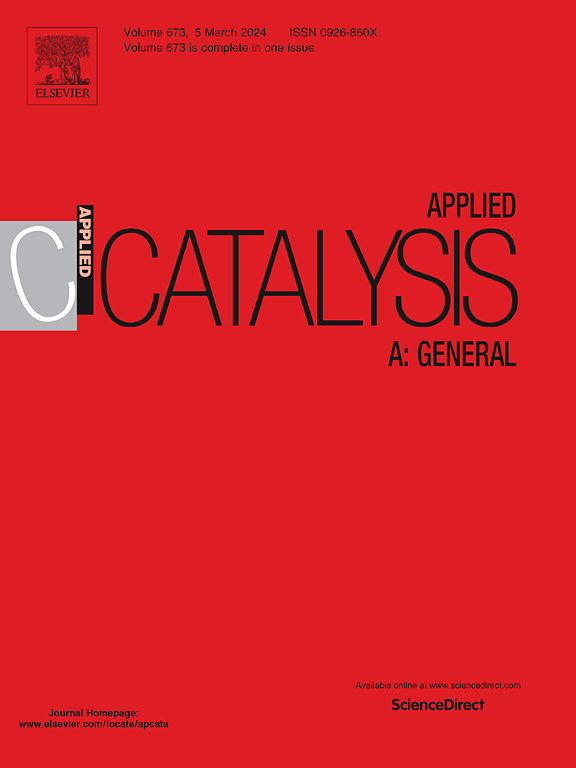Phenolic resin/cadmium selenide heterojunctions for efficient hydrogen peroxide production with broad-spectrum light utilization
IF 4.8
2区 化学
Q2 CHEMISTRY, PHYSICAL
引用次数: 0
Abstract
The efficient and sustainable production of hydrogen peroxide (H₂O₂) via solar-driven photocatalysis is hindered by poor charge separation and limited light absorption. To address these challenges, we present a novel S-scheme heterojunction photocatalyst composed of cadmium selenide (CdSe) nanoparticles and phenolic resin (RF523). The integration of RF523 with CdSe promotes efficient charge separation by generating a built-in electric field, reducing electron-hole recombination. This design enhances both the oxidation and reduction capabilities of the materials and expands spectral absorption to the near-infrared region (800 nm), which is underutilized in conventional systems. The RF/CdSe-100 composite demonstrated a remarkable H₂O₂ production rate of 888.9 μmol·h⁻¹ under full-spectrum light, outperforming mechanically mixed samples by a factor of 2.0. Additionally, the composite exhibited broad-spectrum light absorption, with an apparent quantum yield of 19.0 % under 365 nm light and 1.7 % under 800 nm light, highlighting its ability to efficiently utilize a wide range of solar energy. The photocatalytic mechanism is driven by the S-scheme charge transfer process, enhancing redox efficiency and promoting the generation of reactive oxygen species (ROS) for H₂O₂ production. This work offers an efficient strategy for solar-driven H₂O₂ synthesis, advancing the design of photocatalysts for renewable energy and environmental applications.
酚醛树脂/硒化镉异质结用于广谱光高效过氧化氢生产
通过太阳能驱动的光催化高效和可持续地生产过氧化氢(H₂O₂)受到电荷分离不良和光吸收有限的阻碍。为了解决这些挑战,我们提出了一种由硒化镉(CdSe)纳米颗粒和酚醛树脂(RF523)组成的新型S-scheme异质结光催化剂。RF523与CdSe的集成通过产生内置电场来促进有效的电荷分离,减少电子-空穴复合。该设计增强了材料的氧化和还原能力,并将光谱吸收扩展到近红外区域(800 nm),这在传统系统中未得到充分利用。RF/CdSe-100复合材料在全光谱下的H₂O₂产率为888.9 μmol·H⁻¹,比机械混合样品的产率高2.0倍。此外,该复合材料具有广谱光吸收能力,在365 nm光下的表观量子产率为19.0 %,在800 nm光下的表观量子产率为1.7 %,表明其能够有效利用广泛的太阳能。光催化机制由S-scheme电荷转移过程驱动,提高氧化还原效率,促进活性氧(ROS)的生成以产生H₂O₂。这项工作为太阳能驱动的H₂O₂合成提供了一种有效的策略,推进了可再生能源和环境应用的光催化剂的设计。
本文章由计算机程序翻译,如有差异,请以英文原文为准。
求助全文
约1分钟内获得全文
求助全文
来源期刊

Applied Catalysis A: General
化学-环境科学
CiteScore
9.00
自引率
5.50%
发文量
415
审稿时长
24 days
期刊介绍:
Applied Catalysis A: General publishes original papers on all aspects of catalysis of basic and practical interest to chemical scientists in both industrial and academic fields, with an emphasis onnew understanding of catalysts and catalytic reactions, new catalytic materials, new techniques, and new processes, especially those that have potential practical implications.
Papers that report results of a thorough study or optimization of systems or processes that are well understood, widely studied, or minor variations of known ones are discouraged. Authors should include statements in a separate section "Justification for Publication" of how the manuscript fits the scope of the journal in the cover letter to the editors. Submissions without such justification will be rejected without review.
 求助内容:
求助内容: 应助结果提醒方式:
应助结果提醒方式:


